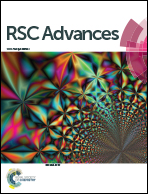Enhancing the removal efficiency of methylene blue in water by fly ash via a modified adsorbent with alkaline thermal hydrolysis treatment
Abstract
An effective adsorbent of methylene blue was synthesized from coal fly ash (FA; waste material from a coal power plant) by a denaturing process with an alkaline solution at 90 °C. The denatured fly ash (D-FA) has a surface area and pore volume of 66.39 m2 g−1 and 15.33 cm3 g−1, respectively, whereas the values of the original FA are negligible, i.e., 3.55 m2 g−1 and 0.02 cm3 g−1. The removal of methylene blue (MB) in aqueous solution by D-FA was increased in the range of initial MB concentration (10–20 mg L−1); contact time (0–120 min); pH (2–8); D-FA dosage (1–4 g L−1). However, a larger value of those operational parameters would not improve the removal activity. Furthermore, the methylene blue adsorption on the denatured FA was fitted with the Langmuir model with R2 = 0.9991; the maximum adsorption capacity was determined as 28.65 mg g−1 from the model. Overall, the highest removal efficiency of MB using D-FA with the dosage of 4 g L−1 was 97.1% in 30 mg L−1 solution of methylene blue at pH = 7. The alkaline hydrothermal denaturation of waste FA is a promising approach to produce an adsorbent with beneficial environmental engineering applications.



 Please wait while we load your content...
Please wait while we load your content...